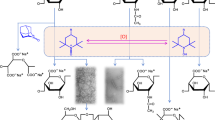Abstract
Various cellulose samples were oxidized by 2,2,6,6,-tetramethylpipelidine-1-oxyl radical (TEMPO)-NaBr-NaClO systems, and the effects of oxidation conditions on chemical structures and degrees of polymerization of the products obtained were studied. In the case of regenerated and mercerized celluloses, almost all C6 primary alcohol groups were selectively oxidized to carboxyl groups, and water-soluble polyglucuronic acid (cellouronic acid) sodium salts were obtained almost quantitatively; the degrees of polymerization were influenced greatly by the amount of TEMPO added, and the oxidation time and temperatures. Cellouronic acids prepared from mercerized linter and kraft pulps had size exclusion chromatograms with two separate peaks due to higher and lower molecular weight fractions. On the other hand, only small amounts of carboxyl groups were introduced into native cellulose samples. Since polyglucuronic acids prepared from cellulose by the TEMPO–NaBr– NaClO systems regularly consist of the glucuronic acid repeating unit, differing from the conventional water-soluble cellulose derivatives, they may open new fields of cellulose utilization.
Similar content being viewed by others
REFERENCES
Chang, P. S. and Robyt, J. F. (1996) Oxidation of primary alcohol groups of naturally occurring polysaccharides with 2,2,6,6-tetramethyl-1-pipelidine oxoammonium ion. Carbohydr. Chem. 15, 819-830.
Davidson, G. F. (1938) The effect of alkalis on the molecular chain length of chemically modified cotton cellulose, as shown by fluidity measurements on the derived nitrocelluloses. J. Text. Inst. 29, T195-T218.
Davis, N. J. and Flitsch, S. L. (1993) Selective oxidation of monosaccharide derivatives to uronic acids. Tetrahedron Lett. 34, 1181-1184.
Isogai A. and Atalla, R. H. (1991) Amorphous cellulose stable in aqueous media: regeneration from SO2-amine solvent systems. J. Polym. Sci., Polym. Chem. Ed. 29, 113-119.
Jackson, E. L. and Hudson, C. S. (1937) Application of the cleavage type of oxidation by periodic acid to starch and cellulose. J. Am Chem. Soc. 59, 2049-2050.
Head, R. S. H. and Hughes, G. (1954) The oxidation of cellobiose by periodate. J. Chem. Soc. 603-606.
Maekawa, E. and Koshijima, T. (1984) Properties of 2,3-dicarboxyl cellulose combined with various metal ions. J. Appl. Polym. Sci. 29, 2289-2297.
McLaughlin, R. R. and Herbst, J. H. E. (1950) Preparation of sodium carboxymethyl-cellulose. Can J. Chem. 28B, 731-736.
Nevell, T. P. (1951) Oxidation of cotton cellulose by nitrogen dioxide. J. Textile Inst. 42, T91-T129.
Nooy, A. E., Besemer, A. C. and Bekkum, H. (1995) Highly selective nitroxyl radical-mediated oxidation of primary alcohol groups in water-soluble glucans. Carbohydr. Res. 269, 89-98.
Nooy, A. E., Besemer, A. C., Bekkum, H., VanDijk, J. A. P. P. and Smit, J. A. M. (1996) TEMPO mediated oxidation of pullulan and influence of ionic strength and linear charge density on the dimensions of the obtained polyelectrolyte chains. Macromolecules 29, 6541-6547.
Tappi Test Method, Cupriethylenediamine disperse viscosity of pulp. T254 om-85 (1997).
Yackel, E. C. and Kenyon, W. O. (1942) The oxidation of cellulose by nitrogen dioxide. J. Am. Chem. Soc. 64, 121-127.
Author information
Authors and Affiliations
Rights and permissions
About this article
Cite this article
Isogai, A., Kato, Y. Preparation of Polyuronic Acid from Cellulose by TEMPO-mediated Oxidation. Cellulose 5, 153–164 (1998). https://doi.org/10.1023/A:1009208603673
Issue Date:
DOI: https://doi.org/10.1023/A:1009208603673




